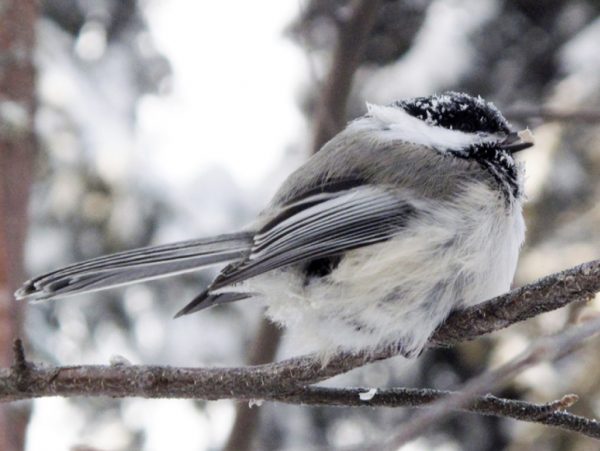Alaska chickadees are brainy birds
November 8, 2018
Ned Rozell
907-474-7468

Alaska chickadees have proven themselves brainier than Colorado chickadees.
A researcher at the University of California, Davis once compared black-capped chickadees from Anchorage to chickadees from Windsor, Colorado, and found that the Alaska birds cached more sunflower seeds and found the seeds quicker when they later searched for them. The Alaska chickadees also had brains that contained more neurons than Colorado chickadees.
Vladimir Pravosudov of UC Davis’ Department of Psychology performed the study to test the notion that northern birds would be better at hiding and finding seeds than birds in a more moderate climate.
He chose to capture birds in Anchorage, which has a day length of about 5 hours, 30 minutes on Dec. 22, and compare them to birds he captured near Windsor, Colorado, about 50 miles north of Denver, where the Dec. 22 day length is about 9 hours, 15 minutes.
With the help of biologist Colleen Handel of the U.S. Geological Survey in Anchorage, Pravosudov captured 15 black-capped chickadees using a mist net at bird feeders around Anchorage in fall 2000. He later captured 12 black-capped chickadees near Windsor, Colorado.
All the birds returned to his lab at UC Davis, where he gave the birds the same food and amount of daylight for 45 days. After 45 days he tested eight birds from Alaska and eight from Colorado in a room with 70 caching holes drilled in wooden blocks and trees.
In late summer through fall, black-capped chickadees gather and hide seeds, insects and other foods to retrieve later, when they have fewer hours of daylight to feed and less food is available. Though black-capped chickadees live their entire lives within a few square acres, the species ranges from as far north as Anaktuvuk Pass to as far south as New Mexico.
All black-capped chickadees cache food, but Pravosudov and other researchers wanted to find out whether northern birds are better at hiding and finding food because of shorter days and colder temperatures.
The tests supported that theory. The Alaska birds cached about twice as many sunflower seeds as the Colorado birds and later found them with about one quarter as many tries per seed. The Alaska birds performed about the same as the Colorado birds on a test of learning to associate a color with a food, but Pravosudov said the Alaska birds also had a larger hippocampus, an area of the brain linked to memory.
The results of the experiment did not surprise Susan Sharbaugh, an expert on chickadees formerly with the University of Alaska Fairbanks Institute of Arctic Biology. Alaska’s winters probably do a good job of choosing birds that have good memories, she said.
“It’s a great example of natural selection,” she said. “Tough winters winnow out the ones that can’t remember where their caches are. In the Lower 48, if a chickadee has a good memory, it’s fine; up here you have to have a great memory.”
Since the late 1970s, the University of Alaska Fairbanks' Geophysical Institute has provided this column free in cooperation with the UAF research community. Ned Rozell is a science writer for the Geophysical Institute. A version of this column appeared in 2004.


